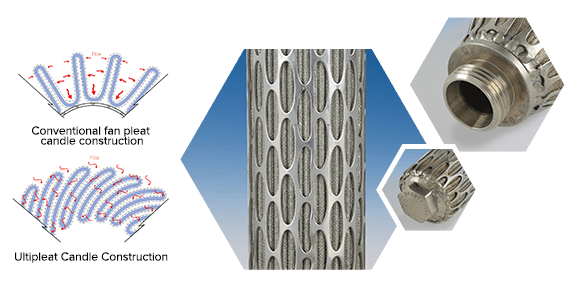Balanced Filtration for Optimal Polymer Production
Pall’s balanced filtration of polymer melts enhances filtration performance and facilitates continuous operation for a truly optimized process. Faced with rising production costs and increased competition, manufacturers in the polymers industry must find new ways to cut expenses, enhance efficiency, and decrease the amount of costly product contamination. Meeting these challenges requires real solutions that match the right product with the right application. Melt filtration is the final polymer filtration step of the Polycarbonate production process, and is critical to ensuring the final product is of the highest quality.
The primary purpose for polymer melt processing is to remove hard contamination as well as soft particles such as gels or undissolved polymer. The particle size distribution for both the hard and soft contamination is largely unknown and depends on factors like feedstock quality, feedstock filtration, catalyst, additives, process stability, etc.
Nonwoven filter media is a generic term that includes a wide variety of filtration and separation media. Identifying and selecting the right filter media from the many choices that are available is critical to matching the right filter to an application.
Pall filtration experts strive to meet the needs of Balanced Filtration for Optimal Polymer Production and the final melt filtration. We take into consideration how each filter component interacts in the overall process. When the product quality objectives dictate fine filtration at the final polymer melt processing stage, it is imperative that all feed stream is filtered to a level equal to or better than the final melt filter.
Optimum filter media choice and size indicates that the recommended filter system is balanced, which means the contaminant load is evenly shared among all process filters. Since each stream entering the process has been filtered, the final polymer melt filter will only need to remove particulate and gel contamination generated internally. The right filters throughout the process are then chosen to assist in the longevity for final melt filter.
Ensuring a proper balanced system of the right filter products can help you achieve long uninterrupted run times at the critical melt filter position, product quality, product reliability, high yields, and reasonable cost.
Key to Balancing Your Filtration Process in Final Melt Filtration
- Define the appropriate final melt filter to remove undesirable gels and particulate matter. Ensure final polymer characteristics necessary to produce the desired film, fiber, or resin product quality.
- Be selective when choosing filters for reactant fluid stream such as monomers, comonomers, initiator, solvents, additives, catalysts, etc. Eliminates harmful particulate contaminants and ensures efficacious polymerization.
- Specify the appropriate oligomer or polymer intermediate filtration. Reduces process generated gels and particles, enhancing polymer quality and extending the life of the final polymer melt filter.
- Utilize correct cartridge filtration to remove all agglomerates and oversized particles from additive slurries. Ensures well dispersed flurries, improving, end product quality and extending the on-stream life of the final melt filters.
As the global leader in high-tech polymer filtration solutions, Pall polymer melt filtration solutions have been extensively used by most major industry players for production of a variety of polymer types.





